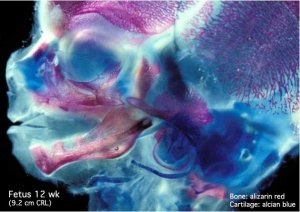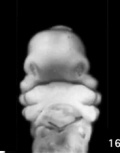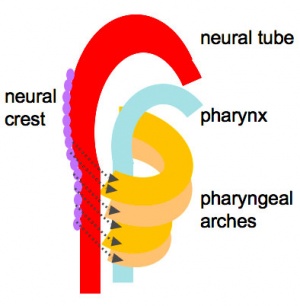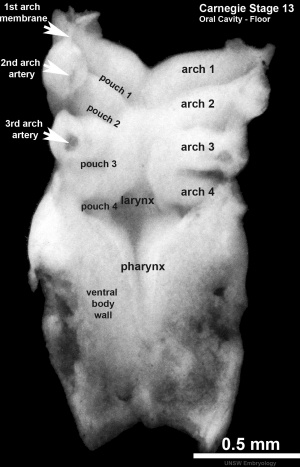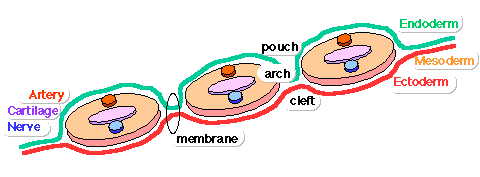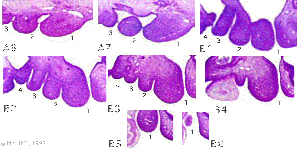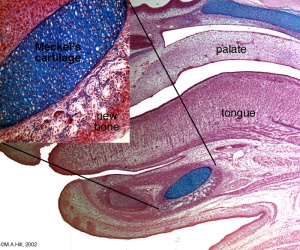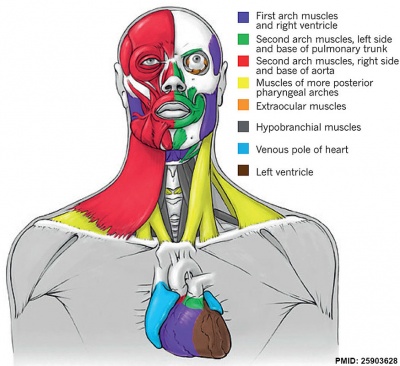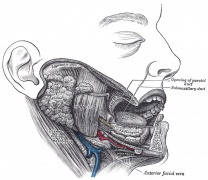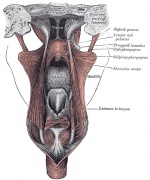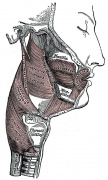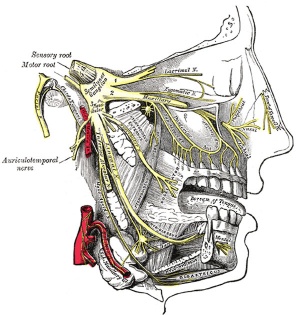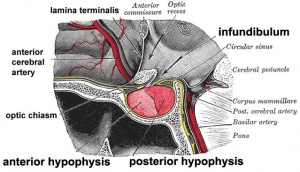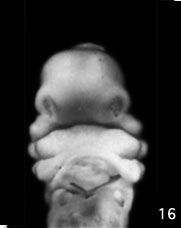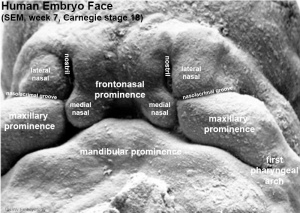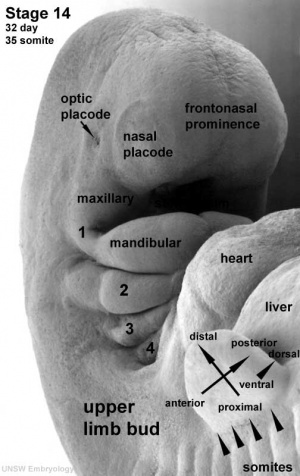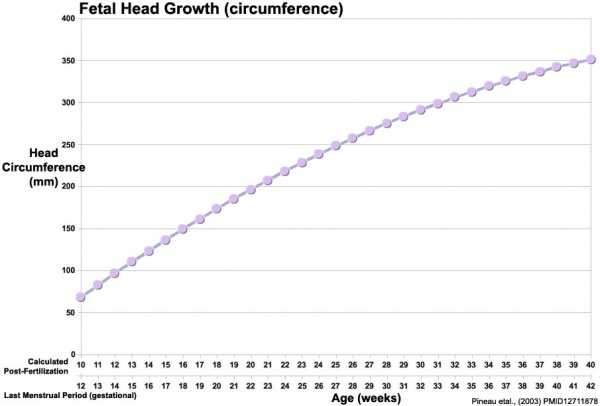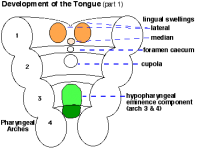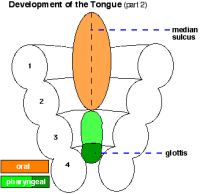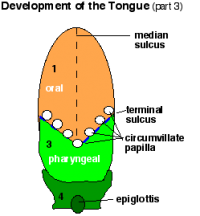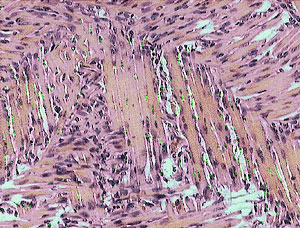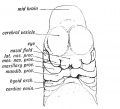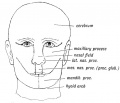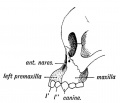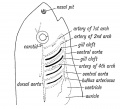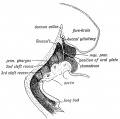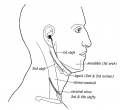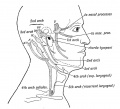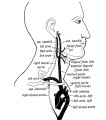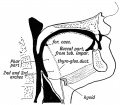Head Development
| Embryology - 10 May 2024 |
|---|
| Google Translate - select your language from the list shown below (this will open a new external page) |
|
العربية | català | 中文 | 中國傳統的 | français | Deutsche | עִברִית | हिंदी | bahasa Indonesia | italiano | 日本語 | 한국어 | မြန်မာ | Pilipino | Polskie | português | ਪੰਜਾਬੀ ਦੇ | Română | русский | Español | Swahili | Svensk | ไทย | Türkçe | اردو | ייִדיש | Tiếng Việt These external translations are automated and may not be accurate. (More? About Translations) |
Introduction
The head and neck is not really a "system", but structurally quite different in origin from the body. The head and neck are one of the most complicated structures that the embryo forms, with special intermediate structures (the pharyngeal arch) and contributions from all 3 embryonic layers (ectoderm, mesoderm, endoderm), and significantly, a major contribution from the neural crest. Neural crest contributes jaw skeletal elements, connective tissues and tendons. The associated muscles derive mainly from cranial mesoderm. These components though will form different structures dependent upon which arch they are within. The cavity within the pharyngeal arches forms the pharynx.
The pharynx contributes to 2 endocrine organs, in the roof the pituitary (hypophysis) and the floor the thyroid. The thyroid gland, being one of the first endocrine organs to be formed, has an important role in embryonic development. The pharynx floor of all arches also contribute to the formation of the tongue.
Because the head contains many different structures also review notes on: skull, sensory (placode, vision, hearing, smell, taste), respiratory (pharynx), integumentary(tooth, hair) and endocrine (pituitary, thyroid, parathyroid, thymus).
Some Recent Findings
|
| More recent papers |
|---|
|
This table allows an automated computer search of the external PubMed database using the listed "Search term" text link.
More? References | Discussion Page | Journal Searches | 2019 References | 2020 References Search term: Head Development | Pharyngeal Arch Development | Skull Development | Face Development | |
| Older papers |
|---|
| These papers originally appeared in the Some Recent Findings table, but as that list grew in length have now been shuffled down to this collapsible table.
See also the Discussion Page for other references listed by year and References on this current page.
|
Textbooks
- The Developing Human: Clinically Oriented Embryology (8th Edition) by Keith L. Moore and T.V.N Persaud - Moore & Persaud Chapter Chapter 10 The Pharyngeal Apparatus pp201 - 240.
- Larsen’s Human Embryology by GC. Schoenwolf, SB. Bleyl, PR. Brauer and PH. Francis-West - Chapter 12 Development of the Head, the Neck, the Eyes, and the Ears pp349 - 418.
| Head Movies | ||||||||||||||||||||||||||||
|---|---|---|---|---|---|---|---|---|---|---|---|---|---|---|---|---|---|---|---|---|---|---|---|---|---|---|---|---|
|
| |||||||||||||||||||||||||||
|
|
|
|
|
| |||||||||||||||||||||||
| UNSW Students | |
|---|---|
| You have access the following online Embryology textbooks through the UNSW Library. | |

|
Moore, K.L. & Persuad, T.V.N. (2008). The Developing Human: clinically oriented embryology (8th ed.). Philadelphia: Saunders.
The following chapter links only work with a UNSW connection. |
Objectives
- List the main structures derived from the pharyngeal arches, pouches and clefts.
- Know the stages and structures involved in the development of the face.
- Predict the results of abnormal development of the face and palate.
- Briefly summarise the development of the tongue.
The Pharynx
The cavity within the pharyngeal arches forms the pharynx.
The pharynx contributes to 2 endocrine organs, in the roof the [endocrine7.htm pituitary] (hypophysis) and the floor the thyroid. The thyroid gland being one of the first endocrine organs to be formed has an important role in embryonic development. The pharynx floor of all arches also contribute to the formation of the [head6.htm tongue].
Pharyngeal Arch Components
Major features to identify for each: arch, pouch, groove and membrane. Contribute to the formation of head and neck and in the human appear at the 4th week. The first arch contributes the majority of upper and lower jaw structures.
Early Face and Pharynx
- Pharynx - begins at the buccopharyngeal membrane (oral membrane), apposition of ectoderm with endoderm (no mesoderm between)
Pharyngeal Arch Development
- branchial arch (Gk. branchia= gill)
- arch consists of all 3 trilaminar embryo layers
- ectoderm- outside
- mesoderm- core of mesenchyme
- endoderm- inside
Neural Crest
- Mesenchyme invaded by neural crest generating connective tissue components
- cartilage, bone, ligaments
- arises from midbrain and hindbrain region
Arch Features
Each arch contains: artery, cartilage, nerve, muscular component
Arches and Phanynx Form the face, tongue, lips, jaws, palate, pharynx and neck cranial nerves, sense organ components, glands
- Humans have 5 arches - 1, 2, 3, 4, 6 (Arch 5 does not form or regresses rapidly)
- from in rostro-caudal sequence, Arch 1 to 6 from week 4 onwards
- arch 1 and 2 appear at time of closure of cranial neuropore
- Face - mainly arch 1 and 2
- Neck components - arch 3 and 4 (arch 4 and 6 fuse)
Arch Features
- arch
- groove
- externally separates each arch
- also called a cleft
- only first pair persist as external auditory meatus
- externally separates each arch
- pouch
- internally separates each arch
- pockets from the pharynx
- membrane
- ectoderm and endoderm contact regions
- only first pair persist as tympanic membrane
- Pharyngeal Arch 1 (Mandibular Arch) has 2 prominances
- smaller upper- maxillary forms maxilla, zygomatic bone and squamous part of temporal
- larger lower- mandibular, forms mandible
- Pharyngeal Arch 2 (Hyoid Arch)
- forms most of hyoid bone
- Arch 3 and 4
- neck structures
Arch Arteries
placental vein -> liver -> heart -> truncus arteriosus -> aortic sac -> arch arteries -> dorsal aorta -> placental artery |

Human embryo (5mm, lateral view) showing pulmonary arteries |
| Arch 5 Artery? |
|---|
| There has been ongoing controversy as to whether the fifth arch artery, that forms in fish, ever develops in birds and mammals. A recent study in mouse and human embryos identified the presence of an extra vessel presence in a single Carnegie Stage 14 human embryo.[5] |
| Congdon (1922) Table 1 | |||||||||||||||||||||||||||||||||||||||||||||||||||||||||||||||||||||||||||||||||||||||||||||||||||||||||||||||||||||||||||||||||||||||||||||||||||||||||||
|---|---|---|---|---|---|---|---|---|---|---|---|---|---|---|---|---|---|---|---|---|---|---|---|---|---|---|---|---|---|---|---|---|---|---|---|---|---|---|---|---|---|---|---|---|---|---|---|---|---|---|---|---|---|---|---|---|---|---|---|---|---|---|---|---|---|---|---|---|---|---|---|---|---|---|---|---|---|---|---|---|---|---|---|---|---|---|---|---|---|---|---|---|---|---|---|---|---|---|---|---|---|---|---|---|---|---|---|---|---|---|---|---|---|---|---|---|---|---|---|---|---|---|---|---|---|---|---|---|---|---|---|---|---|---|---|---|---|---|---|---|---|---|---|---|---|---|---|---|---|---|---|---|---|---|---|
| |||||||||||||||||||||||||||||||||||||||||||||||||||||||||||||||||||||||||||||||||||||||||||||||||||||||||||||||||||||||||||||||||||||||||||||||||||||||||||
Arch Cartilage
- Arch 1 - Meckel's cartilage, horseshoe shaped
- dorsal ends form malleus and incus
- midpart forms ligaments (ant. malleus, sphenomandibular)
- ventral part forms mandible template
- Arch 2 - Reichert's cartilage
- dorsal ends form stapes and Temporal bone styloid process
- ventral part ossifies to form hyoid bone components
- lesser cornu and superior body
- Arch 3- forms greater cornu and inferior part of hyoid
- Arch 4&6- form laryngeal cartilages, except epiglottis (from hypobranchial eminence)
Arch Muscle
- Arch 1 - muscles of mastication, mylohyoid, tensor tympanic, ant. belly digastric
- Arch 2 - muscles of facial expression, stapedius, stylohyoid, post. belly digastric
- Arch 3 - stylopharyngeus
- Arch 4&6 - crycothyroid, pharynx constrictors, larynx muscles, oesophagus (st. muscle)
Head and Heart Muscle[6] On the left side of the body (right part of figure) the facial expression muscles have been removed to show the masticatory muscles.
Arch Nerve
- Arch 1 - CN V trigeminal, caudal 2/3 maxillary and mandibular, cranial 1/3 sensory nerve of head and neck, mastication motor
- Arch 2 - CN VII facial
- Arch 3 - CN IX glossopharyngeal
- Arch 4&6 - CN X vagus, arch 4- superior laryngeal, arch 6- recurrent laryngeal
Arch Pouches
- Arch 1 - elongates to form tubotympanic recess, tympanic cavity, mastoid antrum, eustachian tube
- Arch 2 - forms tonsillar sinus, mostly oblierated by palatine tonsil
- Arch 3 - forms inferior parathyroid and thymus
- Arch 4 - forms superior parathyroid, parafollicular cells of Thyroid
Thyroid Gland
- not a pouch structure
- first endocrine organ to develop day 24
- from floor of pharynx
- descends thyroglossal duct (which closes)
- upper end at foramen cecum
Anterior Pituitary
- not a pouch structure
- boundary epitheilal ectoderm in the roof of the pharynx
- forms a pocket (Rathke's pouch) that comes into contact with the ectoderm of developing brain.
- Rathke's pouch is named after German embryologist and anatomist Martin Heinrich Rathke (1793 — 1860).
Face Development
Begins week 4 centered around stomodeum, external depression at oral membrane
5 initial primordia from neural crest mesenchyme
- single frontonasal prominence (FNP) - forms forehead, nose dorsum and apex
- nasal placodes develop later bilateral, pushed medially
- paired maxillary prominences - form upper cheek and upper lip
- paired mandibular prominences - lower cheek, chin and lower lip
Frontonasal Process
The frontonasal process (FNP) forms the majority of the superior part of the early face primordia. It later fuses with the maxillary component of the first pharyngeal arch to form the upper jaw. Failure of this fusion event during the embryonic period leads to cleft lip. Under the surface ectoderm the process mesenchyme consists of two cell populations; neural crest cells, forming the connective tissues; and the mesoderm forming the endothelium of the vascular network.
A chicken developmental model study has identified a specific surface region, the Frontonasal Ectodermal Zone (FEZ), initially induced by bone morphogenetic proteins that appears to regulate the future growth and patterning of the frontonasal process. The specific frontonasal ectodermal zone was located in the frontonasal process ectoderm flanking a boundary between Sonic hedgehog (Shh) and Fibroblast growth factor 8 (Fgf8) expression domains.[7]
Head/Skull
|
|
Sensory Placodes
- During week 4 a series of thickened surface ectodermal patches form in pairs rostro-caudally in the head region.
- Recent research suggests that all sensory placodes may arise from common panplacodal primordium origin around the neural plate, and then differentiate to eventually have different developmental fates.
- These sensory placodes will later contribute key components of each of our special senses (vision, hearing and smell). Other species have a number of additional placodes which form other sensory structures (fish, lateral line receptor). Note that their initial postion on the developing head is significantly different to their final position in the future sensory system
Otic placode
in the stage 13/14 embryo (shown below) the otic placode has sunk from the surface ectoderm to form a hollow epithelial ball, the otocyst, which now lies beneath the surface surrounded by mesenchyme (mesoderm). The epithelia of this ball varies in thickness and has begun to distort, it will eventually form the inner ear membranous labyrinth.
Lens placode
lies on the surface, adjacent to the outpocketing of the nervous system (which will for the retina) and will form the lens.
- Links: Lens Development
Nasal placode
has 2 components (medial and lateral) and will form the nose olfactory epithelium.
- Links: Smell Development | Placodes
Head Growth
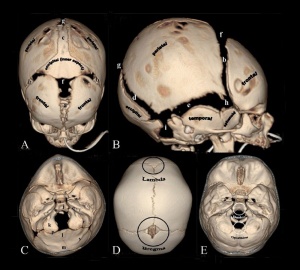
- continues postnatally - fontanelle allow head distortion on birth and early growth
- bone plates remain unfused to allow growth, puberty growth of face
Fetal head growth (circumference)
Skull Overview
Chondrocranium - formed from paraxial mesoderm
- cranial end of vertebral column
- modified vertebral elements
- occipital and cervical sclerotome
- bone preformed in cartilage (endochondrial ossification)
Cranial Vault and Facial Skeleton - formed from neural crest
- muscle is paraxial mesoderm
- somitomeres and occipital somites
Calveria - bone has no cartilage (direct ossification of mesenchyme)
- bones do not fuse, fibrous sutures 1. allow distortion to pass through birth canal 2. allow growth of the brain
- 6 fontanelles, posterior closes at 3 months, anterior closes at 18 months
- Links: Skull Development
Palate
The palate has two key stages of development during embryonic and an early fetal involving the fusion of structures (epithelia to mesenchymal).
Embryonic
Primary palate, fusion in the human embryo between stage 17 and 18, from an epithelial seam to the mesenchymal bridge.
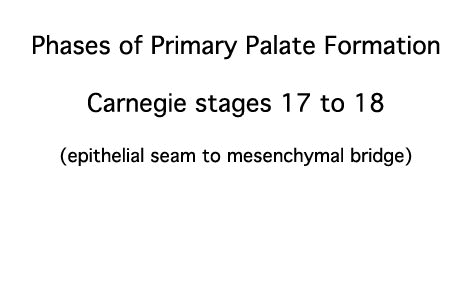
Fetal
Secondary palate, fusion in the human embryo in week 9. This requires the early palatal shelves growth, elevation and fusion during the early embryonic period. The fusion event is to both each other and the primary palate. palatal shelf elevation | secondary palate
- Links: palate
Ear Auricles
- form from 6 hillocks (week 5)
- 3 on each of arch 1 and 2
Tongue Development
- Ectoderm of the first arch surrounding the stomodeum forms the epithelium lining the buccal cavity.
- Also the salivary glands, enamel of the teeth, epithelium of the body of the tongue.
- As the tongue develops "inside" the floor of the oral cavity, it is not readily visible in the external views of the embryonic (Carnegie) stages of development.
- Contributions from all arches, which changes with time
- begins as swelling rostral to foramen cecum, median tongue bud
- Arch 1 - oral part of tongue (ant 3/2)
- Arch 2 - initial contribution to surface is lost
- Arch 3 - pharyngeal part of tongue (post 1/3)
- Arch 4 - epiglottis and adjacent regions
Tongue muscle
- Tongue muscles originate from the somites.
- Tongue muscles develop before masticatory muscles and is completed by birth.
- Masticatory muscles originate from the somitomeres.
- These muscles develop late and are not complete even at birth.
Salivary Glands
- epithelial buds in oral cavity (week 6 to 7) extend into mesenchyme
- parotid, submandibular, sublingual
Pharyngeal Arch Tables
| Pharyngeal Arch | Nerve | Artery | Neural Crest (Skeletal Structures) |
Muscles | Ligaments |
|---|---|---|---|---|---|
| 1 (maxillary/mandibular) |
trigeminal (CN V) | maxillary artery (terminal branches) | mandible, maxilla, malleus, incus | muscles of mastication, mylohyoid, tensor tympanic, ant. belly digastric | ant lig of malleus, sphenomandibular ligament |
| 2 (hyoid) |
facial (CN VII) | stapedial (embryonic) corticotympanic (adult) |
stapes, styloid process, lesser cornu of hyoid, upper part of body of hyoid bone | muscles of facial expression, stapedius, stylohyoid, post. belly digastric | stylohyoid ligament |
| 3 | glossopharyngeal (CN IX) | common carotid, internal carotid arteries | greater cornu of hyoid, lower part of body of hyoid bone | stylopharyngeus | |
| 4 | vagus (CN X) superior laryngeal branch | part of aortic arch (left), part right subclavian artery (right) | thyroid, cricoid, arytenoid, corniculate and cuneform cartilages | crycothyroid, soft palate levator veli palatini (not tensor veli palatini) | |
| 6 | vagus (CN X) recurrent laryngeal branch | part of left pulmonary artery (left), part of right pulmonary artery (right) | thyroid, cricoid, arytenoid, corniculate and cuneform cartilages | larynx intrinsic muscles (not cricothyroid muscle) |
Structures derived from Pouches
Each pouch is lined with endoderm and generates specific structures.
| Overall Structure | Specific Structures | |
| tubotympanic recess | tympanic membrane, tympanic cavity, mastoid antrum, auditory tube | |
| intratonsillar cleft | crypts of palatine tonsil, lymphatic nodules of palatine tonsil | |
| inferior parathyroid gland, thymus gland | ||
| superior parathyroid gland, ultimobranchial body | ||
| becomes part of 4th pouch |
Structures derived from Grooves
Only the first groove differentiates into an adult structure and forms part of the external acoustic meatus.
Structures derived from Membranes
At the bottom of each groove lies the membrane which is formed from the contact region of ectodermal groove and endodermal pouch. Only the first membrane differentiates into an adult structure and forms the tympanic membrane.
Movies
There are a number of movies representing development of different features of the head and face.
|
|
|
|
|
- Links: Head and Face Movies | Movies
References
- ↑ Nagarajan M, Sharbidre KG, Bhabad SH & Byrd SE. (2018). MR Imaging of the Fetal Face: Comprehensive Review. Radiographics , , 170142. PMID: 29652578 DOI.
- ↑ Li W, Xu H, Zhao L & Li X. (2018). Branchial anomalies in children: A report of 105 surgical cases. Int. J. Pediatr. Otorhinolaryngol. , 104, 14-18. PMID: 29287855 DOI.
- ↑ Graham A & Richardson J. (2012). Developmental and evolutionary origins of the pharyngeal apparatus. Evodevo , 3, 24. PMID: 23020903 DOI.
- ↑ Talbot JC, Johnson SL & Kimmel CB. (2010). hand2 and Dlx genes specify dorsal, intermediate and ventral domains within zebrafish pharyngeal arches. Development , 137, 2507-17. PMID: 20573696 DOI.
- ↑ Bamforth SD, Chaudhry B, Bennett M, Wilson R, Mohun TJ, Van Mierop LH, Henderson DJ & Anderson RH. (2013). Clarification of the identity of the mammalian fifth pharyngeal arch artery. Clin Anat , 26, 173-82. PMID: 22623372 DOI.
- ↑ Diogo R, Kelly RG, Christiaen L, Levine M, Ziermann JM, Molnar JL, Noden DM & Tzahor E. (2015). A new heart for a new head in vertebrate cardiopharyngeal evolution. Nature , 520, 466-73. PMID: 25903628 DOI.
- ↑ Foppiano S, Hu D & Marcucio RS. (2007). Signaling by bone morphogenetic proteins directs formation of an ectodermal signaling center that regulates craniofacial development. Dev. Biol. , 312, 103-14. PMID: 18028903 DOI.
Reviews
Gupta P, Tripathi T, Singh N, Bhutiani N, Rai P & Gopal R. (2020). A review of genetics of nasal development and morphological variation. J Family Med Prim Care , 9, 1825-1833. PMID: 32670926 DOI.
Nagarajan M, Sharbidre KG, Bhabad SH & Byrd SE. (2018). MR Imaging of the Fetal Face: Comprehensive Review. Radiographics , , 170142. PMID: 29652578 DOI.
Abramyan J & Richman JM. (2018). Craniofacial development: discoveries made in the chicken embryo. Int. J. Dev. Biol. , 62, 97-107. PMID: 29616744 DOI.
Adameyko I & Fried K. (2016). The Nervous System Orchestrates and Integrates Craniofacial Development: A Review. Front Physiol , 7, 49. PMID: 26924989 DOI.
Kuratani S & Schilling T. (2008). Head segmentation in vertebrates. Integr. Comp. Biol. , 48, 604-10. PMID: 20607135 DOI.
Grevellec A & Tucker AS. (2010). The pharyngeal pouches and clefts: Development, evolution, structure and derivatives. Semin. Cell Dev. Biol. , 21, 325-32. PMID: 20144910 DOI.
Articles
Choe CP & Crump JG. (2015). Dynamic epithelia of the developing vertebrate face. Curr. Opin. Genet. Dev. , 32, 66-72. PMID: 25748249 DOI.
Shone V & Graham A. (2014). Endodermal/ectodermal interfaces during pharyngeal segmentation in vertebrates. J. Anat. , 225, 479-91. PMID: 25201771 DOI.
Thi Thu HN, Haw Tien SF, Loh SL, Bok Yan JS & Korzh V. (2013). Tbx2a is required for specification of endodermal pouches during development of the pharyngeal arches. PLoS ONE , 8, e77171. PMID: 24130849 DOI.
Search PubMed
Search term: Head Development | Pharyngeal Arch Development | | Face Development
NCBI - Policies and Guidelines | PubMed | Help:Reference Tutorial
Books
Hinrichsen K. The early development of morphology and patterns of the face in the human embryo. Berlin ; New York : Springer-Verlag, c1985
Additional Images
Historic
| Historic Disclaimer - information about historic embryology pages |
|---|
| Pages where the terms "Historic" (textbooks, papers, people, recommendations) appear on this site, and sections within pages where this disclaimer appears, indicate that the content and scientific understanding are specific to the time of publication. This means that while some scientific descriptions are still accurate, the terminology and interpretation of the developmental mechanisms reflect the understanding at the time of original publication and those of the preceding periods, these terms, interpretations and recommendations may not reflect our current scientific understanding. (More? Embryology History | Historic Embryology Papers) |
Development of the Pharynx and Neck
Terms
| Head Terms (expand to view) |
|---|
|
| Other Terms Lists |
|---|
| Terms Lists: ART | Birth | Bone | Cardiovascular | Cell Division | Endocrine | Gastrointestinal | Genital | Genetic | Head | Hearing | Heart | Immune | Integumentary | Neonatal | Neural | Oocyte | Palate | Placenta | Radiation | Renal | Respiratory | Spermatozoa | Statistics | Tooth | Ultrasound | Vision | Historic | Drugs | Glossary |
| Palate Development (expand to see terms) |
|---|
|
| Other Terms Lists |
|---|
| Terms Lists: ART | Birth | Bone | Cardiovascular | Cell Division | Endocrine | Gastrointestinal | Genital | Genetic | Head | Hearing | Heart | Immune | Integumentary | Neonatal | Neural | Oocyte | Palate | Placenta | Radiation | Renal | Respiratory | Spermatozoa | Statistics | Tooth | Ultrasound | Vision | Historic | Drugs | Glossary |
Glossary Links
- Glossary: A | B | C | D | E | F | G | H | I | J | K | L | M | N | O | P | Q | R | S | T | U | V | W | X | Y | Z | Numbers | Symbols | Term Link
External Links
External Links Notice - The dynamic nature of the internet may mean that some of these listed links may no longer function. If the link no longer works search the web with the link text or name. Links to any external commercial sites are provided for information purposes only and should never be considered an endorsement. UNSW Embryology is provided as an educational resource with no clinical information or commercial affiliation.
- Essentials of Facial Growth Enlow and Hans
Cite this page: Hill, M.A. (2024, May 10) Embryology Head Development. Retrieved from https://embryology.med.unsw.edu.au/embryology/index.php/Head_Development
- © Dr Mark Hill 2024, UNSW Embryology ISBN: 978 0 7334 2609 4 - UNSW CRICOS Provider Code No. 00098G
